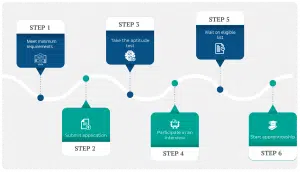The Hogan Assessments are used by potential employers to determine whether you are a good fit for a position. The Hogan Personality Inventory (HPI) shows hiring managers and HR teams how you relate to others when you are at your best. In contrast, the Hogan Development Survey (HDS) looks at the dark side of your personality, allowing them to mitigate performance risks before they are an issue. The Motives, Values, Preferences Inventory (MVPI) examines your core values and motivations.
The Hogan test is untimed, but each test takes about 15-20 minutes to complete. You may be required to take any combination of the three but the HPI is the most popular Hogan assessment among recruiters, the HDS is the second most used, and the MVPI is the least used among the three.
Did you know?
The Hogan Assessment test contains three unique assessments. The (1) Hogan Personality Inventory (HPI) assesses your normative personality, the (2) Hogan Development Survey (HDS) measures your personality under duress, and the Motives, Values, Preferences Inventory (MVPI) examines your core goals, values, drives, and interests. While trying to fake answers is ill-advised, with the right coaching and practice, you can improve your chances of success.
Technically, there are no right or wrong answers on a personality test. However, there are techniques and strategies you can use while answering the questions to give yourself a leg up on the competition.
Hogan Assessment Question Types Explained
All three Hogan assessments give a statement and ask you to rate your agreement with it, whether you strongly agree, agree, disagree, or strongly disagree with it, or state whether you agree, disagree or are undecided.
Hogan Personality Assessments Comparison Table
| Assessment | Hogan Personality Inventory | Hogan Development Survey | Motives, Values, Preferences Inventory |
|---|---|---|---|
| Acronym | HPI | HDS | MVPI |
| No. of Statements | 206 items | 168 items | 200 items |
| Completion Time | 15-20 minutes | 15-20 minutes | 15-20 minutes |
| Measures | “Bright-side” personality | “Dark-side” personality | “Inside” personality |
| In a nutshell | Your strengths and success factors, how well you may do at the job | Your potential derailers at work; factors that might undermine your success at the job | The fit level between your core goals, beliefs, and personal values on the one hand, and the work environment and organizational culture on the other hand |
As these are personality tests, there are no right or wrong answers. However, the answers you give will shape the company’s opinion about your personality and whether or not you are the right candidate for the job.
Hogan Personality Inventory (HPI)
The Hogan Personality Inventory asks 4-option rating questions that attempt to show what type of employee you are, how well you lead, and the likelihood of you succeeding in a role. Hogan calls this test a look at the bright side, as it looks at your personality on your best day.
Format of the Hogan Personality Inventory
The HPI assessment is made up of a list of 206 descriptive statements. You will be asked to label your level of agreement with each statement as either strongly agree, agree, disagree, or strongly disagree.
Hogan Personality Inventory Sample Questions
Here are some sample questions you may face during the HPI test.
| Statement | Strongly Agree | Agree | Disagree | Strongly Disagree |
|---|---|---|---|---|
| I enjoy the company of others | ||||
| I find myself curious about how things operate | ||||
| I like working on a team |
Which Personality Traits Are Measured by the Hogan HPI?
HPI Personality Scales
The Hogan Personality Inventory measures you in two different areas. First, it assesses your bright-side personality, which is your normal personality characteristics – qualities that provide insight on how well you may work and how successful you can become at your job. Second, the HPI provides feedback from an occupational perspective – how successful you can be in different types of jobs.
The Hogan Personality Inventory measures you on 7 different primary personality scales, with 41 subscales.
The primary personality scales are:
- Adjustment – measures your stress tolerance, resilience, composure, and optimism
- Ambition – measures your competitive drive, goal orientation, and perceived energy
- Sociability – measures your social energy, relationship building skills, and communication frequency
- Interpersonal Sensitivity – measures your communication style, tact, and relationship management skills
- Prudence – measures your dependability, organizational skills, and detail orientation
- Inquisitive – measures your idea-orientation, curiosity, and willingness to hear new ideas
- Learning Approach – measures your learning style, likelihood of looking up new information, and your ability to stay current
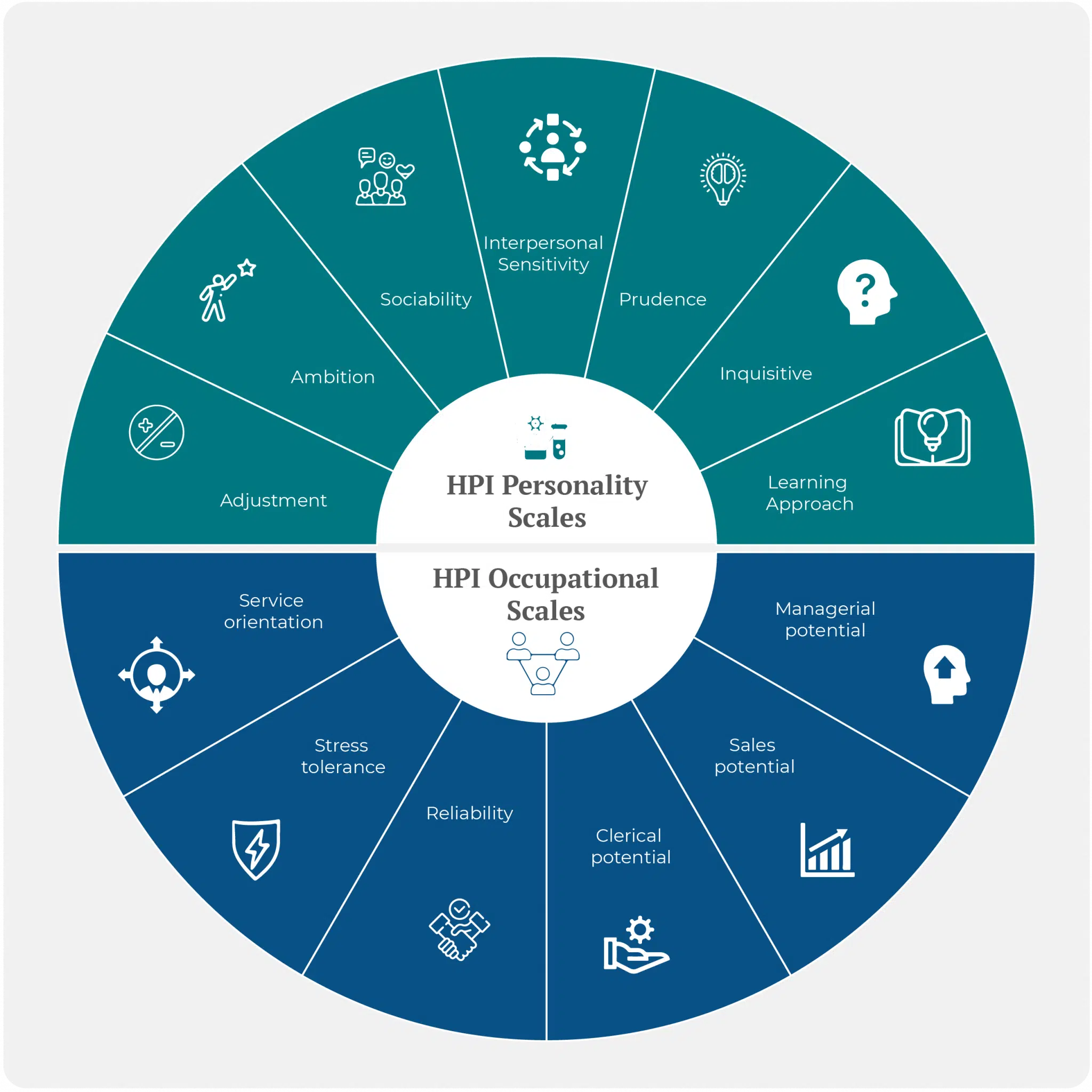
Each of the primary scales also has multiple subscales.
| Adjustment | Ambition | Sociability | Interpersonal Sensitivity |
|---|---|---|---|
| Empathy | Competitive | Likes parties | Easy to live with |
| Not anxious | Self-confident | Likes crowds | Sensitive |
| No guilt | Accomplishment | Experience seeking | Caring |
| Calmness | Leadership | Exhibitionistic | Likes people |
| Even-tempered | Identity | Entertaining | No hostility |
| No complaints | No social anxiety | ||
| Trusting | |||
| Good attachment |
| Prudence | Inquisitiveness | Learning Approach |
|---|---|---|
| Moralistic | Science ability | Education |
| Mastery | Curiosity | Math ability |
| Virtuous | Thrill-seeking | Good memory |
| Not autonomous | Intellectual games | Reading |
| Not spontaneous | Generates ideas | |
| Impulse control | culture | |
| Avoids trouble | ||
Your responses to questions are translated into scores, which are organized by scale
| HPI Primary Scales | Low scores indicate | High scores indicate |
|---|---|---|
| Adjustment | You are open to feedback, but can be moody and self-critical | You are calm and steady under pressure, but might be resistant to feedback |
| Ambition | You’re a good team player and let others take the lead, but may be complacent | You are energetic and competitive, but may be restless and forceful |
| Sociability | You’re good at working alone and staying quiet, but you may be socially reactive | You are outgoing, talkative, and attention-seeking |
| Interpersonal sensitivity | You’re direct and frank, but can be cold and tough | You are friendly and warm, but avoid conflict |
| Prudence | You’re flexible, open-minded, and impulsive | You are organized, dependable and inflexible |
| Inquisitive | You’re practical but uninventive | You are imaginative, but may be a poor implementor |
| Learning approach | You’re a hands-on learner but technology-averse | You’re interested in learning but intolerant of the uninformed |
HPI Occupational Scales
From an occupational perspective, the HPI looks at the following:
- Service orientation – Your potential of being service-oriented, pleasant, attentive, courteous, and helpful.
- Stress tolerance – Your potential to successfully cope with stress and pressure at work.
- Reliability – Your tendency and willingness to be a conscientious employee, and to comply with the company’s rules and protocols.
- Clerical potential – Your potential to perform well in administrative and clerical jobs.
- Sales potential – Your potential to be a successful and devoted salesperson and to achieve high sales performance.
- Managerial potential – Your potential to become a successful manager and a leader in the organization.
Hogan Development Survey (HDS)
The Hogan Development Survey asks 4-option rating questions that assess the dark side of your personality, to see if you have the qualities that disrupt relationships and interfere with the likelihood of the team’s success when under stress. Hogan calls this test “a look at the dark side,” as it looks at your personality when things aren’t going well.
Format of the Hogan Development Survey
The HDS assessment is made up of a list of 168 descriptive statements. You will be asked to label your level of agreement with each statement as either strongly agree, agree, disagree, or strongly disagree.
Hogan Development Survey Sample Questions
Here are some sample questions you may face during the HDS test.
| Statement | Strongly Agree | Agree | Disagree | Strongly Disagree |
|---|---|---|---|---|
| No challenge scares me at work | ||||
| I set high standards for my work performance | ||||
| I wish I would be more assertive |
Which Personality Traits Are Measured by the Hogan HDS?
HDS measurement scales
The Hogan Development Survey assesses your dark-side personality, which is how your personality is reflected during low periods at work, high pressure, and while facing adversity. The primary scales of the Hogan HDS describe 11 potentially derailing behaviors that may arise in such periods. It reports how prone you are to exhibit these derailing behaviors and how these might be realized during your work. These are important aspects to examine in comparison to the demands and potential stressful scenarios that are native to your potential job.
The Hogan HDS measures you on 11 different primary personality scales, with 33 subscales.
The primary scales are:
- Excitable – measures whether you work with passion and enthusiasm, and looks at whether you become frustrated, moody, irritable, and are inclined to give up on projects and people
- Skeptical – measures whether you are alert for signs of deceptive behavior in colleagues and whether you take action when it is discovered
- Cautious – measures your risk aversion, fear of failure, and how you avoid criticism
- Reserved – measures whether you act tough, aloof, remote, and unconcerned with the feelings of others
- Leisurely – measures whether you appear to be friendly and cooperative, but are actually following your own agenda and resisting those of others
- Bold – measures your degree of fearlessness, confidence, and self-assuredness, assessing whether you can admit mistakes and learn from your experience
- Mischievous – measures the degree to which you are impulsive, adventurous, risk seeking, and limit-testing
- Colorful – measures the degree to which you are gregarious, fun, entertaining, and enjoy being in the spotlight
- Imaginative – measures whether you are innovative, creative, possibly eccentric, and self-absorbed
- Diligent – measures whether you are hardworking, detail-oriented, and have high standards of performance for yourself and others
- Dutiful – measures if you are compliant, conforming, and eager to please others
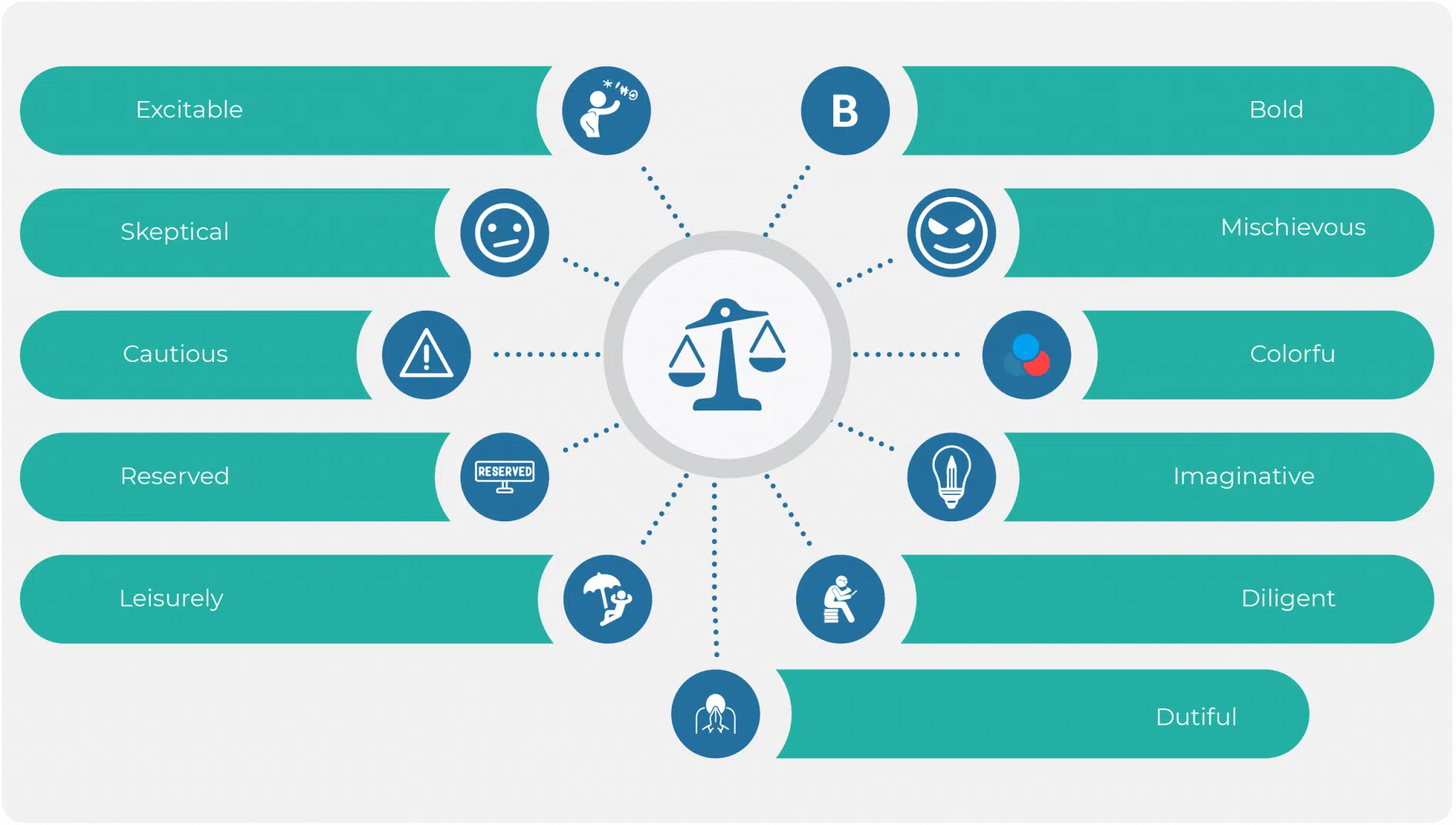
Each of the primary scales also has three subscales.
| HDS Primary Scale | Subscale 1 | Subscale 2 | Subscale 3 |
|---|---|---|---|
| Excitable | Volatile | Easily disappointed | No direction |
| Skeptical | Cynical | Mistrusting | Grudges |
| Cautious | Avoidant | Fearful | Unassertive |
| Reserved | Introverted | Unsocial | Tough |
| Leisurely | Passive-aggressive | Unappreciated | Irritated |
| Bold | Entitled | Overconfidence | Fantasized talent |
| Mischievous | Risky | Impulsive | Manipulative |
| Colorful | Public confidence | Distractible | Self-display |
| Imaginative | Eccentric | Special sensitivity | Creative thinking |
| Diligent | Standards | Perfectionistic | Organized |
| Dutiful | Indecisive | Ingratiating | Conforming |
Your responses to questions are translated into scores, which are organized by scale
| HDS Primary Scale | Low scores indicate | High scores indicate |
|---|---|---|
| Excitable | You seem calm to the point where you lack passion or urgency | You display dramatic emotional peaks and valleys regarding projects and people |
| Skeptical | You seem overly trusting | You seem to be cynical and expect betrayal |
| Cautious | You are willing to take risks without careful consideration | You avoid risk regardless of risk assessment |
| Reserved | You are overly concerned about the feelings of others | You don’t care how others feel |
| Leisurely | You seem to lack an agenda or focus | You are passive-aggressive and agenda-driven |
| Bold | You seem to lack self-confidence | You are assertive and overly self-confident |
| Mischievous | You are compliant and unadventurous | You test limits and can be devious |
| Colorful | You are modest, quiet, and unassuming | You seek attention and are socially prominent |
| Imaginative | You are practical but lack new ideas | You are unpredictable and offer unusual ideas |
| Diligent | You pay poor attention to detail and over-delegate | You are picky and micromanage |
| Dutiful | You are independent and resent authority | You are eager to please management |
Motives, Values, Preferences Inventory (MVPI)
The MVPI asks you to respond True, False, or Undecided to questions that measure your core goals, values, drives, and interests to see the type of role where you would be most productive. Hogan says that this test measures your personal values.
Format of the Motives, Values, Preferences Inventory
The MVPI assessment is made up of a list of 200 descriptive statements. You will be asked to mark whether you agree with the statement, disagree with it, or are undecided.
Motives, Values, and Preferences Inventory Sample Questions
Here are some sample questions you may face during the MVPI test.
| Statement | Agree | Disagree | Undecided |
|---|---|---|---|
| It is more important to be satisfied with your job than to have job security | |||
| My team’s performance reflects on my performance | |||
| I do not like it when work interferes with my time at home |
Which Personality Traits Are Measured by the Hogan MVPI?
Hogan’s Motives, Values, & Preferences Inventory assesses your “inside” personality, which consists of your core goals, values, drivers, and interests. It predicts the type of work you are likely to be happy with and find fulfilling, how well you may fit into the work climate and organizational values, the extent your prospective job will fit your career goals and motivations, and the type of people you will interact well with. All in all, the MVPI assesses how well you will fit in the work environment rather than how well you will do the job.
MVPI measurement scales
The MVPI measures you on 10 different primary scales, with the same 5 subscales for each scale.
The primary scales are:
- Recognition – measures your responsiveness to praise and approval
- Power – measures your desire for success and control
- Hedonism – measures your orientation for fun
- Altruistic – measures your desire to help others and contribute to society
- Affiliation – measures the enjoyment you get from social interaction
- Tradition – measures your dedication to personal beliefs
- Security – measures your need for predictability and order
- Commerce – measures your interest in money and business opportunities
- Aesthetics – measures your need for self-expression, as well as look and feel of work products
- Science – measures your interest in knowledge and data
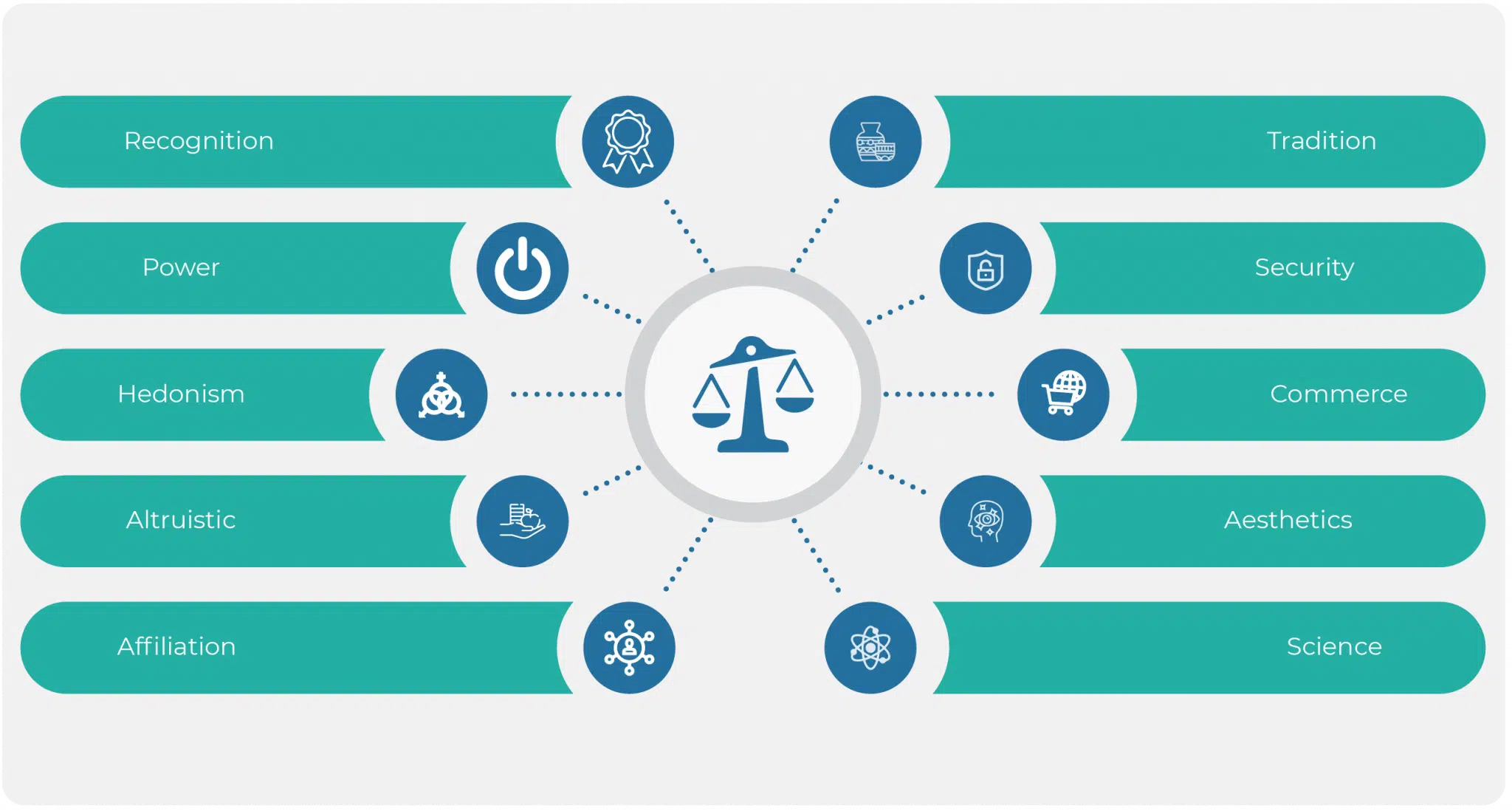
Each of the primary scales also has the same 5 subscales. They are:
- Lifestyle
- Beliefs
- Occupational preferences
- Aversions
- Preferred associates
Your responses to questions are translated into scores, which are organized by scale.
| MVPI Primary Scale | Low scores indicate | High scores indicate |
|---|---|---|
| Recognition | You prefer to share credit, and avoid getting attention | You value acknowledgement and prefer high-visibility projects |
| Power | You prefer to let others take the lead | You prefer opportunities to get ahead |
| Hedonism | You value business-like, formal settings | You value fun and prefer open-minded environments |
| Altruistic | You prefer productivity over morale | You prefer customer-focused environments |
| Affiliation | You value independence and prefer to work alone | You enjoy working on teams |
| Tradition | You value challenging the way things have always been done | You prefer maintaining the status quo |
| Security | You value taking risks | You prefer consistency and predictability |
| Commerce | You value relationships over profitability | You are bottom-line focused |
| Aesthetics | You value practicality and prefer routines | You value innovation |
| Science | You prefer people over technology | You prefer working with data and facts |
Hogan Preparation Strategies
While there are technically no wrong answers on a personality test, the answers you give could disqualify you for a position. For example, answering “Agree” to a question that asks whether others take advantage of you might disqualify you for a managerial position but position you for an assistant role. Understanding why the test is asking certain questions can prepare you to deliver the answers that will help you land the job.
With the right mindset and preparation, you can make yourself familiar with the type of questions you will see on the test, and give the answers the test is looking for.
1. Put Yourself in the Right Frame of Mind
If you’re like most people, you act differently depending on the situation you’re in and the people you are with. While taking the Hogan Assessments, put yourself in the frame of mind that you already have the job you are applying for. In your personal life, you might respond “Strongly Agree” to the statement “I am not a competitive person,” but you want to give the response as if you already had the job.
Research the company and culture beforehand on social media so you can get a sense of the company’s corporate culture, and the answer appropriately. Remember, you’re not faking it. You’re answering as if you were already in the role.
2. Try Some Free Online Personality Tests
Taking practice assessments before your test helps reduce the stress from your test day experience. You will already know what to expect and the types of questions they are asking.
If you are completely new to the concept of personality testing, try to find some adequate free personality tests that offer feedback. Look for serious personality tests, rather than ones that tell you which 70s celebrity you are most like. Nonetheless, there is no replacement for a practice test or preparation course that is dedicated to your Hogan assessment test.
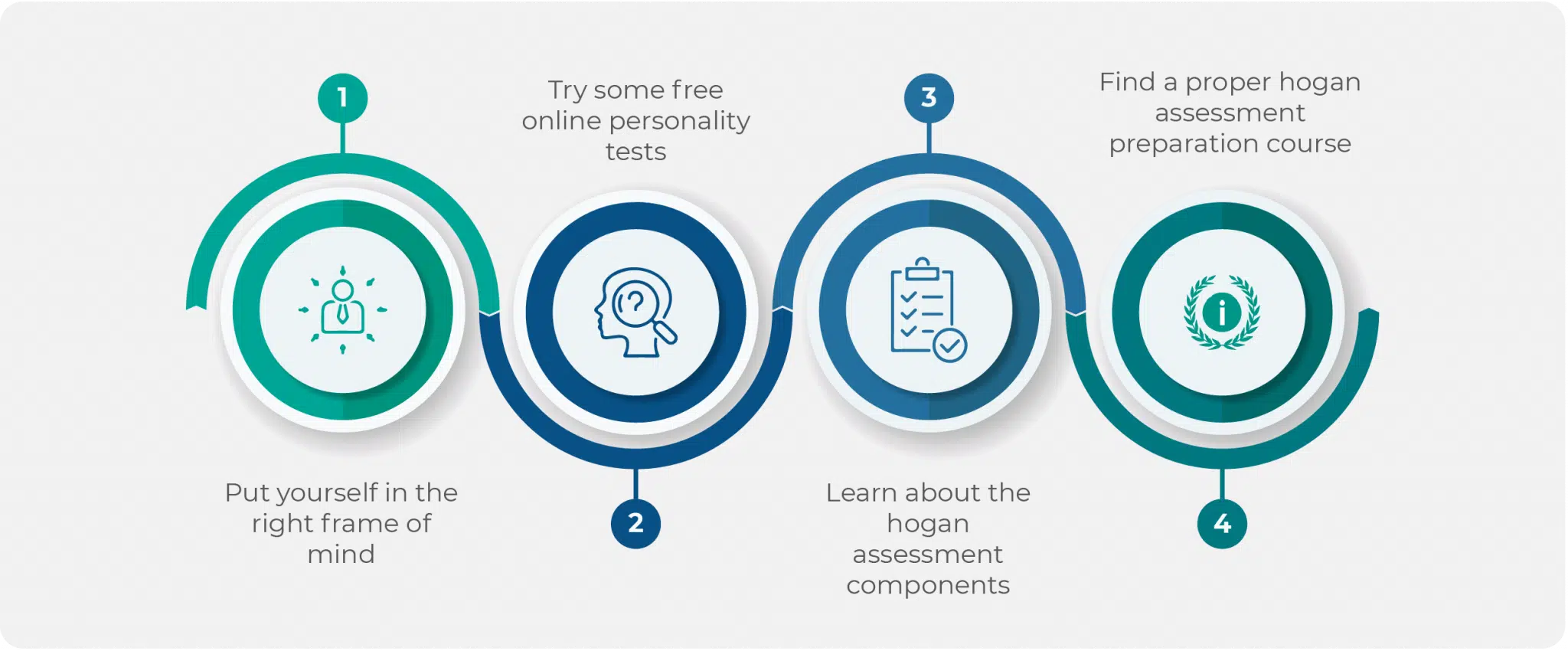
3. Learn about the Hogan Assessment Components
There are a lot of websites that claim to prepare you for any personality test, but you need to prepare specifically for the Hogan Assessment. The HPI, HDS, and MVPI each assess you differently, and failing to prepare for the specific elements of the test is insufficient.
4. Find a Proper Hogan Assessment Preparation Course
Contrary to claims all over the internet, you can prepare for a personality assessment test. Familiarizing yourself with the format and style of the test will make you more comfortable come test day, and understanding what your hiring company is looking for will help frame your responses to questions.
It’s also important to forget everything you may have heard or experienced about personality tests. You may have read that you should never show weakness, don’t exhibit any negative feelings, or answer honestly. Strictly following these pieces of advice will cost you your shot at the job. A professional Hogan Assessment course will guide you to the right approach.
Hogan Test Features
Hogan Assessment Fast Facts (tl;dr)
- HPI – 206 items
- HDS – 168 item
- MVPI – 200 items
- Untimed, although most people complete each test in 15-20 minutes
- Administered online
- Available in over 40 languages
- Hogan scores are delivered in percentile format, compared to large samples of working adults of similar profession
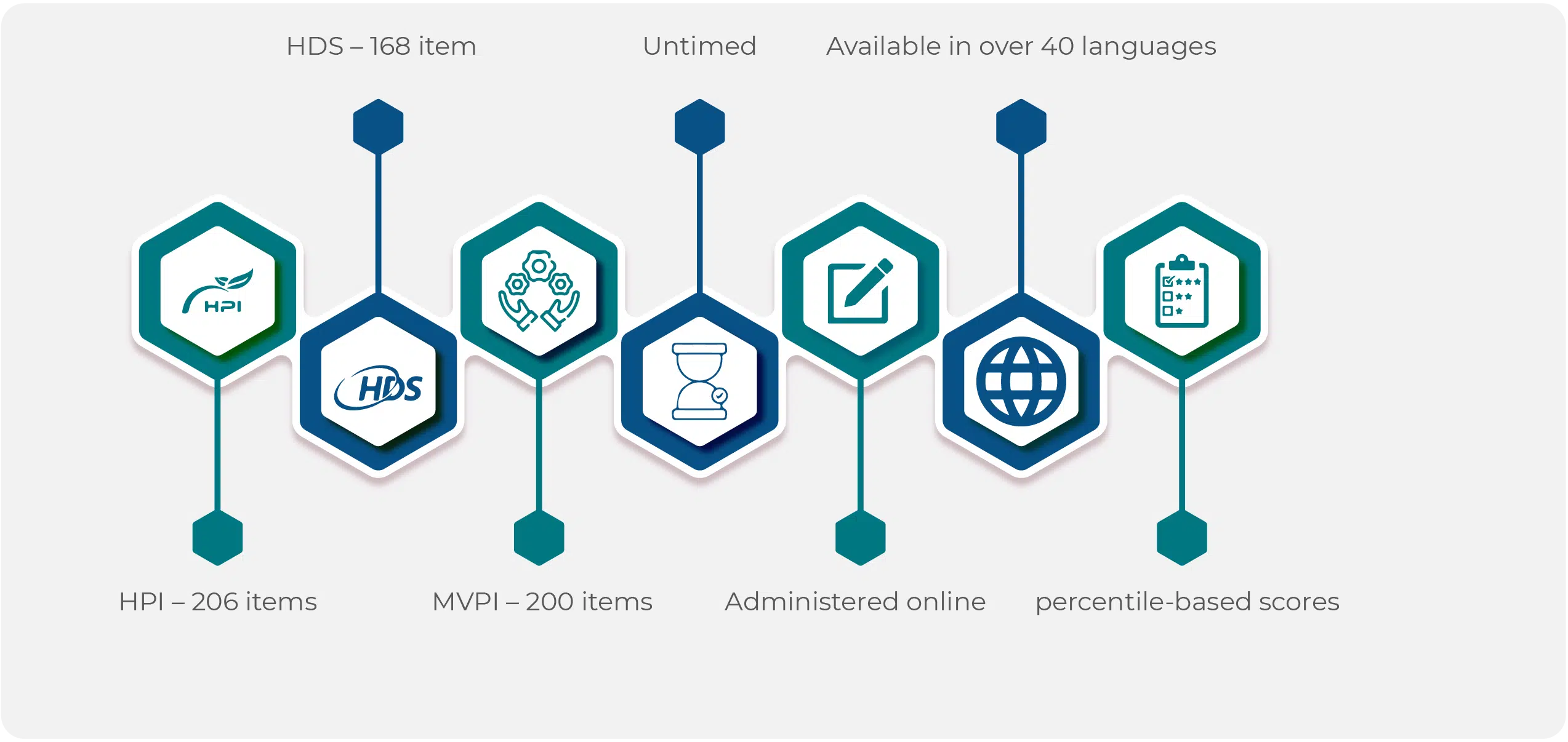
Assesses Three Aspects of your Personality
The Hogan assessment looks at the aspects of your personality
- Bright side personality – your qualities on your best day, and how likely are you to succeed at the job.
- Dark side personality – hidden negatives traits that could derail your career, and undermine your success at the job.
- Personal values – your inner beliefs and motivations that may affect how well you fit in the work environment and organizational culture.
The results of the assessment give employers a full picture of what to expect from you when they hire you.
Bright Side Personality vs. Dark Side Personality
The Hogan Assessment measures what it calls the bright and dark sides of your personality. The HPI measures your bright side, which essentially encompasses qualities that describe how you relate to others when you are at your best.
The HDS delves into the dark side of your personality, looking for hidden personality traits that can derail careers, damage reputations, and hurt the team’s chance of success.
Why Personality Tests are Used to Assess Work Performance Potential
The Hogan assessments help organizations identify the personality traits that might impact an employee’s behavior and performance, as well as identify candidates that will be a good fit for a company’s existing work culture.
“Faking It” Strategy
Research done by Hogan has indicated that “faking” responses doesn’t work. The company studied the results of 6,000 job candidates who were denied a job after taking the test, and then had another opportunity to take the test 6 months later. Those candidates all had good reason to try and manipulate results in their favor, but the final results were all within the standard error of measurement.
Rather than trying to “Fake it,” put yourself in the mindset of the role you are trying to land. That way, when you answer the questions it will come from your professional point of view.
iPREP: Concise. Focused. What you need.
Sign up
Immediate access
Practice
Online self-paced
Pass
Ace that Test!
Technical Facts
Validity of Results
The Hogan Assessment was designed to predict behaviors among potential and existing employees, with the overall goal of improving the organizations that use the tool. For over 30 years, the test has continued to improve. The company focuses on research, to ensure the validity of its personality test. In other words, they ensure that the results that come from the test predict performance.
Assessment Types Explained
While taking the HPI, HDS, and MVPI, you will be expected to read between 168-206 statements and indicate whether you strongly agree, agree, disagree, or strongly disagree with each of them. In the MVPI test, you will have an additional option to answer undecided. There is no time limit, but you are expected to move through each one of the tests in under 20 minutes.
In the HPI and HDS assessments, many of the statements you are given are “I” statements, as the test tries to understand the different aspects of your personality. The MVPI questions ask for your reaction to statements of belief and behaviors.
Language and Geography
The Hogan is available in over 40 different languages and has distributors and partners operating all around the globe.
Results Scale and Interpretations
After completing the test, results are immediately made available to the organization that gave you an assessment. Sharing the results with you is at the discretion of the company that gave you the test. However, as you prepare for the assessment, it is instructive to know the nature of the report that they will receive.
The report shows the fit between you and the position. That fit is based on decades of research, customized for the role that you applied for. The personality you display on the test is compared to the thousands of others who have held the type of role for which you applied. If your personality matches those who have succeeded in the role, you will likely move on in the process.
Hogan Assessment Reports
Each report has three sections. There is an executive summary, percentile scores, and a look at the primary and subscales.
Executive Summary
The report begins with an executive summary. As you can see below, The HPI executive summary focuses on your strengths, the HDS summary focuses on your negative points, and the MVPI discusses your beliefs and motivations.
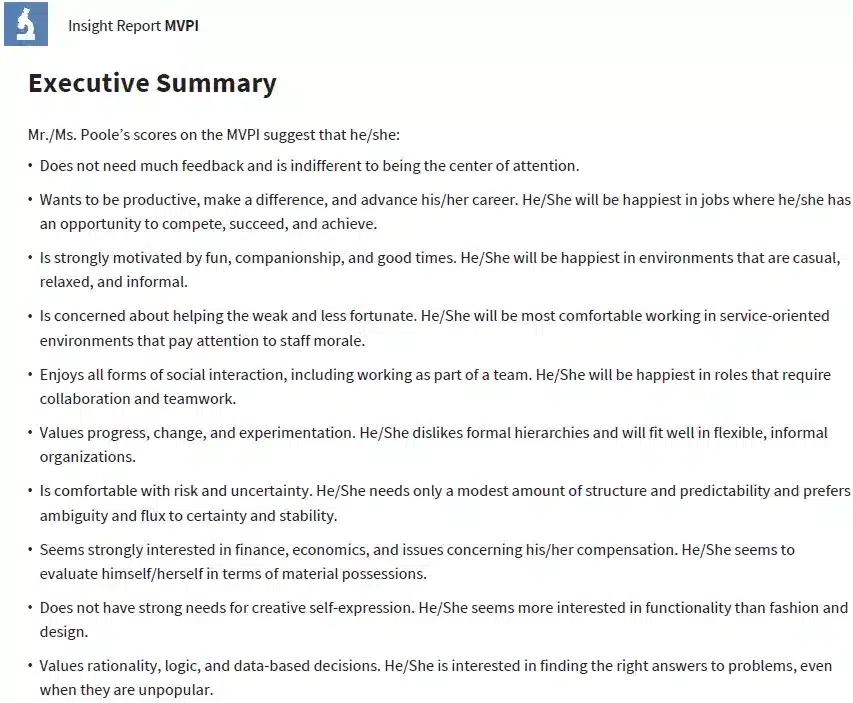
Percentile Scores
In the next section, your potential employer will see how well you performed by percentile. It’s important to remember that the percentile is based on the way your answers are compared to that of people who have succeeded and failed in the type of role you are interviewing for.
This means that your scores cannot be seen as general scores but as a reflection of your personality compared to the ideal personality profile sought for the job.
As you can see in the sample reports below, scores are divided into the different primary scales that each test was designed to measure.
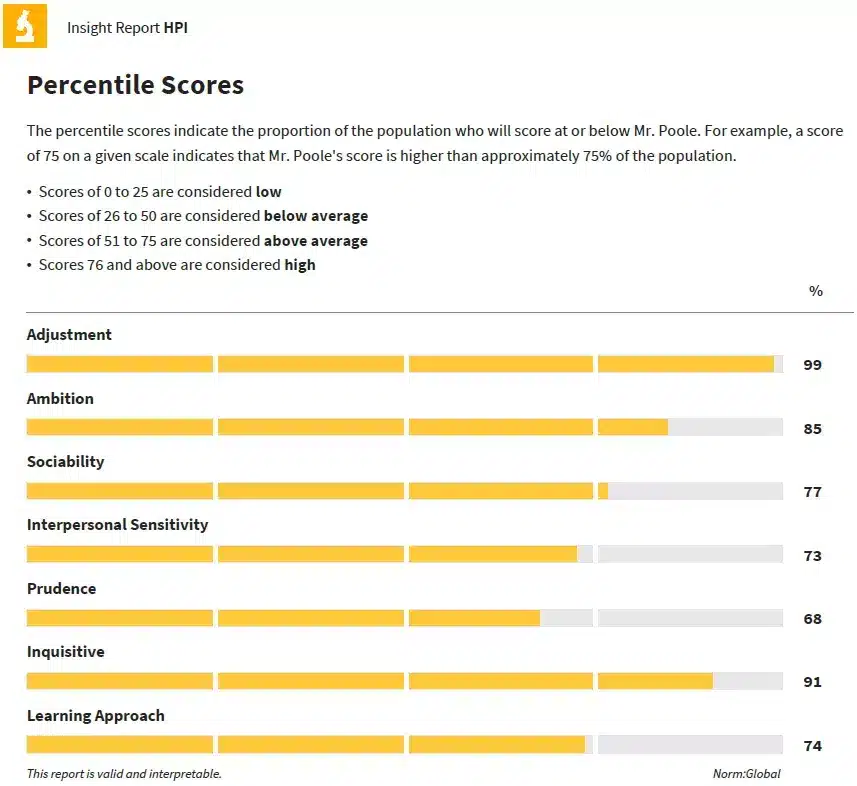
Primary Scales and Sub-scales
In the final section of the report, your employer gets a detailed explanation of your results for each of the scales, as well as the subscales that contributed to the score.
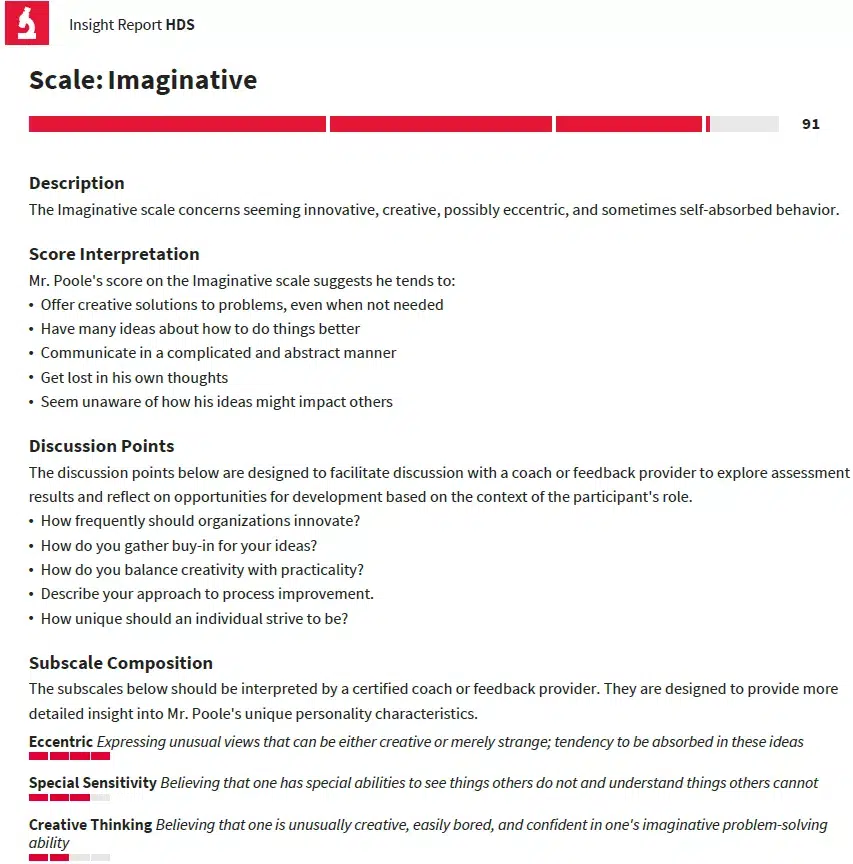
Hogan Assessment FAQs
The Hogan assessment is a series of personality tests used by employers to screen job candidates.
There are three tests in the Hogan Assessment. They are the Hogan Personality Inventory (HPI), the Hogan Development Survey (HDS), and the Motives, Values, Preferences Inventory (MVPI).
Hogan test scores compare your answers to others who have held the type of position you are seeking. It evaluates your personality based on the responses you entered, and then compares your personality to others who have been in that type of role.
Practicing the test can help relax you and help prepare you for the assessment. You should also take a prep course that will prepare you specifically for the Hogan. It can help guide your approach to the test and help improve your chances of getting the job.
It takes about 15-20 minutes to complete each Hogan Assessment.
The HPI has 206 questions, the HDS has 168 questions, and the MVPI has 200 questions.
According to Hogan, they are highly accurate based on statistical research. Whether they are accurate or not, your potential employer believes that they are accurate.
There are no right or wrong answers on the Hogan, so you can’t really fail the assessment. However, your answers could disqualify you from a job that you are well suited for if you are not prepared.
The Hogan report is the report that a company receives after you complete your test.
There isn’t an official assessment called the Hogan profile. However, many people use that term to describe the report employers receive from Hogan after prospective employees complete the set of Hogan personality assessments.
HPI stands for Hogan Personality Inventory, HDS stands for Hogan Development Survey and MVPI stands for Motives, Values, Preferences Inventory.
According to Hogan, people can’t fake results on their test. That being said, there are strategies and approaches you can take to push the results in your favor.
The Hogan uses comprehensive data to ensure that the assessments are accurate. The HPI and HDS are based on a sample of 100,000 people, while the MVPI is based on a sample of 65,000 people.
The Hogan provides results directly to the hiring organization. Whether they let you see your results is at their discretion.
Hogan Assessment Test Tips
1. Be Prepared
If you’ve never taken a personality test before, you may be in for a surprise. Take a prep course so you are prepared on test day.
2. Do your research
Learn what you can about the organizational culture and role before you take the test, so you can answer questions as if you are already in the role.
3. Practice
Sign up for a course like iPrep’s Hogan Assessment course, which will prepare you for how to approach the test.
4. Take care of yourself
Get a good night’s sleep the night before, and have a healthy meal before taking the test. The better you feel, the more likely it is that you will succeed.
5. Breath
Staying calm is critical, but you need to remain calm and show them why you are the best candidate for the job. Remember, you’ve got this.
6. Use Common Sense
Be honest, but bear in mind the position you are trying to get.
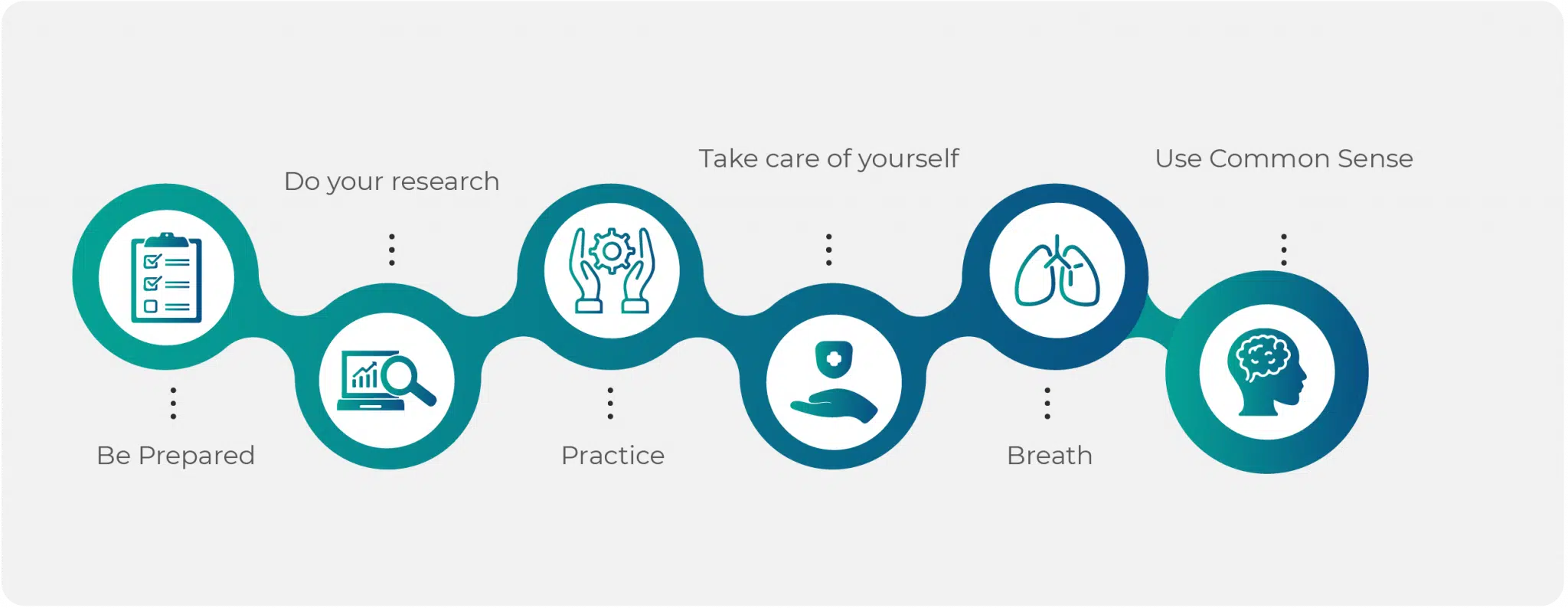
Administration
- Test Location: The Hogan assessments are not proctored and are taken online at home.
- Test Schedule: The test is given as part of the hiring process
- Test Format: Multiple choice on computer
- Test Materials: Test taken on computer
- Cost: Covered by the recruiter
- Retake Policy: Determined by each employer
Test Provider
Hogan was founded by Drs. Joyce and Robert Hogan in 1987. The company began as a small startup, but has grown to serve more than half the Fortune 500 countries. Its tests are administered in 56 countries and in 47 languages.
Information Sources
Disclaimer – All the information and prep materials on iPrep are genuine and were created for tutoring purposes. iPrep is not affiliated with Hogan, which is the owner of the trademarks Hogan Personality Test (HPI), Hogan Development Survey (HDS), Motives, Values, Preferences Inventory (MVPI), or any companies or trademarks that were mentioned above.
Hogan HPI Sample Questions
(your qualities on your best day, and how likely are you to succeed at the job)
Rate your agreement with the following statements:
Statement 1
I often worry about my past mistakes –
- Strongly Agree
- Agree
- Disagree
- Strongly Disagree
The statement “I often worry about my past mistakes” is similar to statements in the HPI’s Adjustment scale and specifically how guilt-free you are. It tries to assess whether you are quick to justify yourself after making a mistake or whether you are prone to worry about past mistakes.
If you answered “True” and you would answer similarly in other cases, it means that you are mistake-averse and tend to feel guilty about your mistakes. It also means that you will do your best to avoid them.
This is an important quality for people who deal with science and very expensive materials, and that any mistake of theirs might be costly for the employer. On the other hand, it is not a highly needed quality for online marketers who practice a lot of trial and error.
Statement 2
I am more ambitious than my friends –
- Strongly Agree
- Agree
- Disagree
- Strongly Disagree
The statement “I am more ambitious than my friends” is similar to statements in the HPI’s Ambition scale and speaks specifically to how competitive you are. It tries to assess whether you enjoy competition, perceive work as a competition with your colleagues, or are rather laid back about it.
Competitiveness is an important quality for positions in which teammates compete for bonuses or other perks. It might be less important and even unwanted for jobs that require collaboration between a few individuals, or in jobs that hardly measure personal achievement.
Hogan HDS Sample Questions
(hidden negative traits that could derail your career, and undermine your success at the job)
Rate your agreement with the following statements:
Statement 1
People have hidden motives when they offer help –
- Strongly Agree
- Agree
- Disagree
- Strongly Disagree
The statement “People have hidden motives when they offer help” is similar to statements in the HDS’s Skeptical scale and specifically how cynical you are. It tries to assess whether you are prone to doubt others’ intentions and assume they have bad ulterior motives.
High scorers on this scale are prone to negativity and are quarrelsome, while low scorers may not examine others’ true intentions carefully enough.
Statement 2
I dress for work so I can blend into the crowd –
- Strongly Agree
- Agree
- Disagree
- Strongly Disagree
The statement “I dress for work so I can blend into the crowd” is similar to statements in the HDS’s Colorful which tries to assess how attention-seeking you are.
Both extremes of this scale may interfere with your work. You may seem too colorful to the point of having no self-restraint. On the other hand, if you are too timid, you may not be able to make a strong impression on others and lack outward confidence.
Hogan MVPI Sample Questions
(inner beliefs and motivations that may affect how well you fit in the work environment)
Mark whether you agree, disagree, or are undecided regarding the following statements.
Statement 1
I prefer spending time with open and outgoing people –
- Agree
- Disagree
- Undecided
The statement “I prefer spending time with open and outgoing people” is similar to statements in the MVPI’s Affiliation scale, which assesses how likely you are to enjoy being in a work environment with high social interaction.
If you agreed with the statement, you may prefer working closely with people and wish to avoid working on your own. If you are undecided about the statement, then maybe you can appreciate jobs with different measures of social interaction.
Statement 2
My friends are always updated with current technology trends –
- Agree
- Disagree
- Undecided
The statement “My friends are always updated with current technology trends” is similar to statements in the MVPI’s Science scale, which measures interest in innovations and obtaining knowledge.
High scorers on this scale probably value analysis and objective facts, while low scorers value people’s intuition more. Respectively, companies that deal with data analysis may prefer people of the first type, and companies that deal with design, creative thinking, and the like will prefer the latter.
Well done!
You have completed the Sample Questions section.
The complete iPREP course includes full test simulations with detailed explanations and study guides.
‘…TESTS THAT ACTUALLY HELP’

In the first 30 minutes of use I have learned so much more than skipping along the internet looking for free content. Don’t waste you time, pay and get tests that actually help.
Richard Rodgers
January 28, 2020 at 7:49 PM
About the course
Welcome to iPrep’s preparation course for the Hogan personality assessments.
This course will help you boost your skills and with it your confidence toward your upcoming Hogan personality assessment. The course will provide you with the following tools and benefits:
- You will become familiar with the Hogan assessments’ format and style of questions.
- You will have access to three full-length Hogan-style simulation tests that follow the most common Hogan personality assessments – HPI, HDS, and MVPI. These simulations include similar statements to what you’ll face in the actual test. Going through these simulations will immediately give you the advantage of familiarity, so you won’t be caught off guard on test day.
- After each test simulation, you will receive a detailed report that indicates the same personality scales as the Hogan personality test. This will help you learn how to identify the trait that each statement is assessing.
- The report can be customized to a selection of over 40 job titles; you could choose the most relevant for your prospective job from the list.
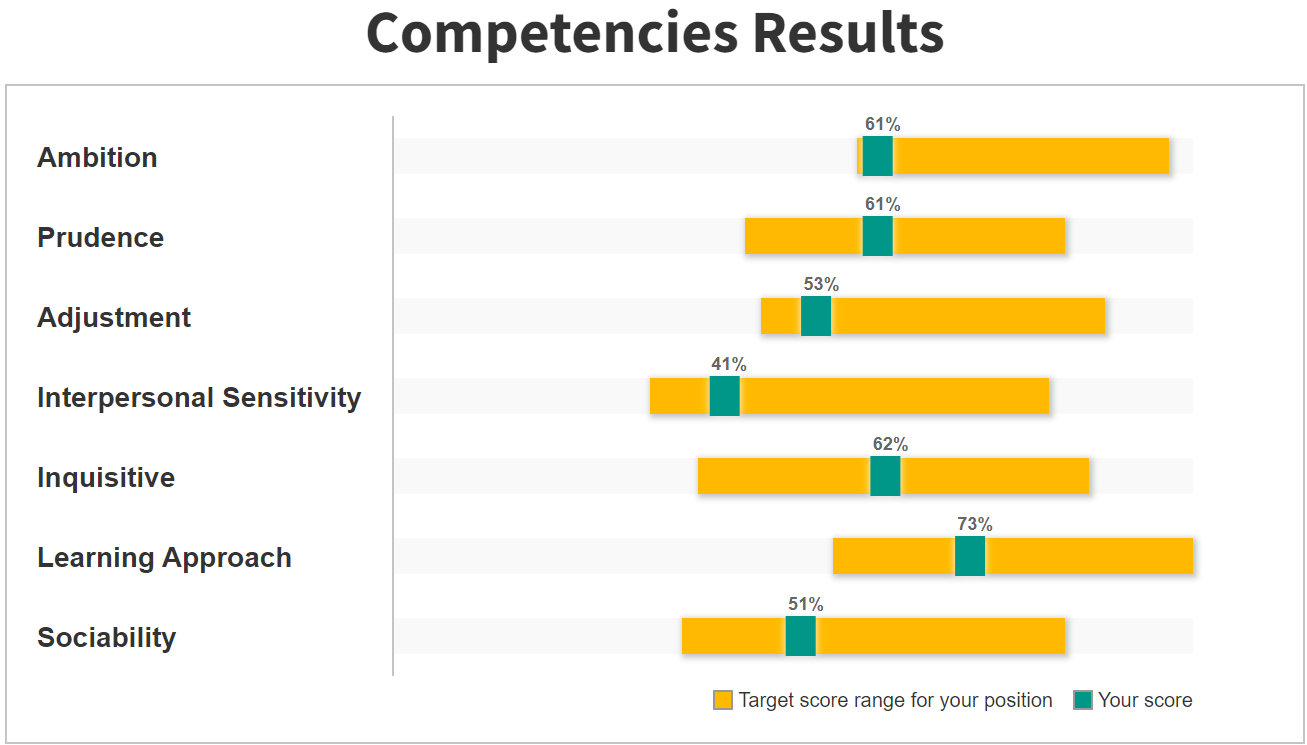
You will be provided with our guide to personality tests. It will introduce you to personality tests, the different question formats you may encounter, and how to approach the test in a way that will significantly increase your chances of success.
9
Learning hours
3 Full
Test simulations
465
test items
30
Day access
By the end of this course, you will be more knowledgeable and comfortable with the Hogan personality assessments – knowledge and familiarity with the test are the two most significant factors that can help you maximize your score and improve your chances of success.
Wishing you an enjoyable learning experience!
Benefits
Test insights
Anxiety Reduction
Test-Taking Tips
Curriculum
- Course Introduction
- About Hogan Personality Assessments
- How to Pass Personality Tests
- Full-Length Hogan Test Simulations
- Course Conclusion
Customer Testimonial

Great course that definitely has increased my understanding of personality tests. Good guide to better get a more accurate assessment of ones work place persona!
Christofer Ashley
January 5, 2022 at 6:16 PM
Reviews

BIANCA T***
March 12, 2025 at 1:01 AM
This was a great study guide to help me pass the exam with the employer! Well worth the money and time to review the material.

Axel W*******
January 14, 2025 at 8:26 AM
What a supporting an wonderful experience! I can only yrecommend doint this preparation to underatand what will happen during these tests.

Tanesha W******
January 5, 2025 at 3:10 PM
This is a wonderful resource and is just what you need to simmer down anxieties and develop confidence in successful completion! I have no doubt that I won't pass this on the first try! Thank you for making this so affordable for the consumer!

M Yamin Y*****
December 29, 2024 at 12:18 PM
One of the better test preparation options, with clear structure and guidance, even if limited practice test repository. Highly recommend.

Thomas R******
November 20, 2024 at 4:05 AM
Excellent course, very informative. Great pre-test. Allows you to see what you will be up against. Gives you the confidence you need.

Claire L******
October 11, 2024 at 9:57 AM
I used iPrep to get ready to take a personality test as part of an interview process. I found the insights provided incredibly useful and appreciated the opportunity to do some practice tests. Would highly recommend. It would be great if there were more tests to practice on

peter h*****
October 3, 2024 at 11:27 AM
Everything works fine. Theory is enough and what I needed to know. The interpretation / explanation of the results were helpful.

Craig L*****
August 22, 2024 at 9:52 PM
I found the iPREP course extremely helpful in getting pass the exam to get the position I applied for! I would greatly recommend this practice exam to anyone that needs to take Hogan assessment.

Mary Lou T*****
July 12, 2024 at 1:02 PM
I was very satisfied with the test prep. I was able to hone into the areas important to management positions and answer truthfully with proper emphasis on areas important to a prospective employer. Money well spent!

Brandon M****
June 11, 2024 at 10:13 PM
Very good course that was insightful and provided valuable tips to better understanding testing purpose and outcomes. A truly valuable investment.
